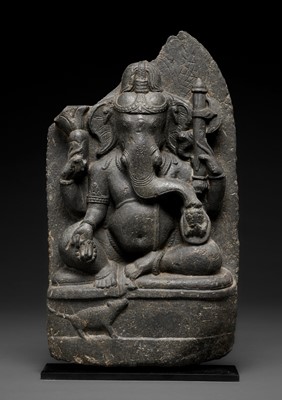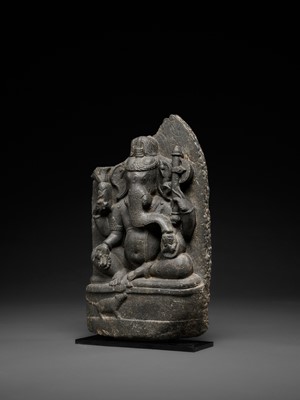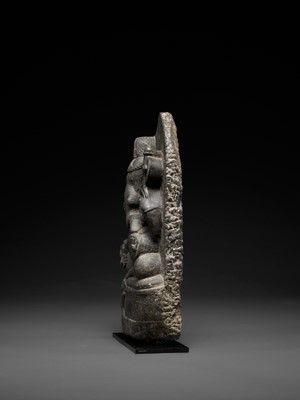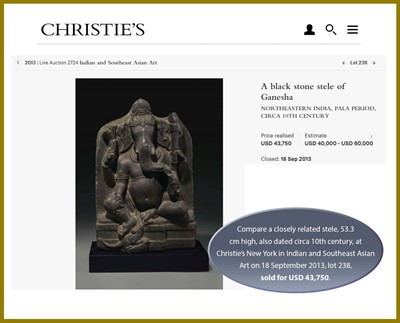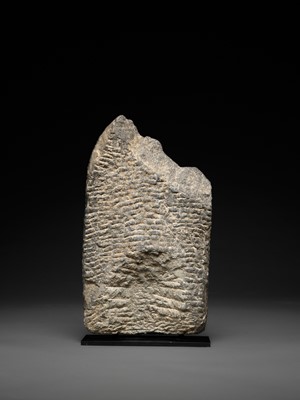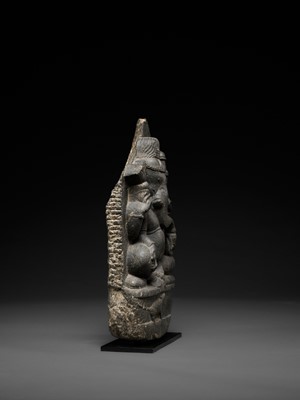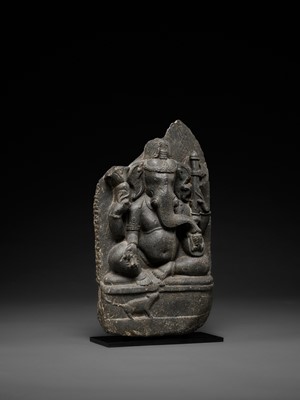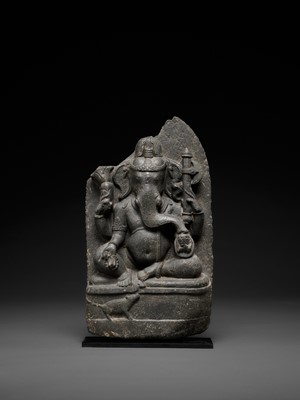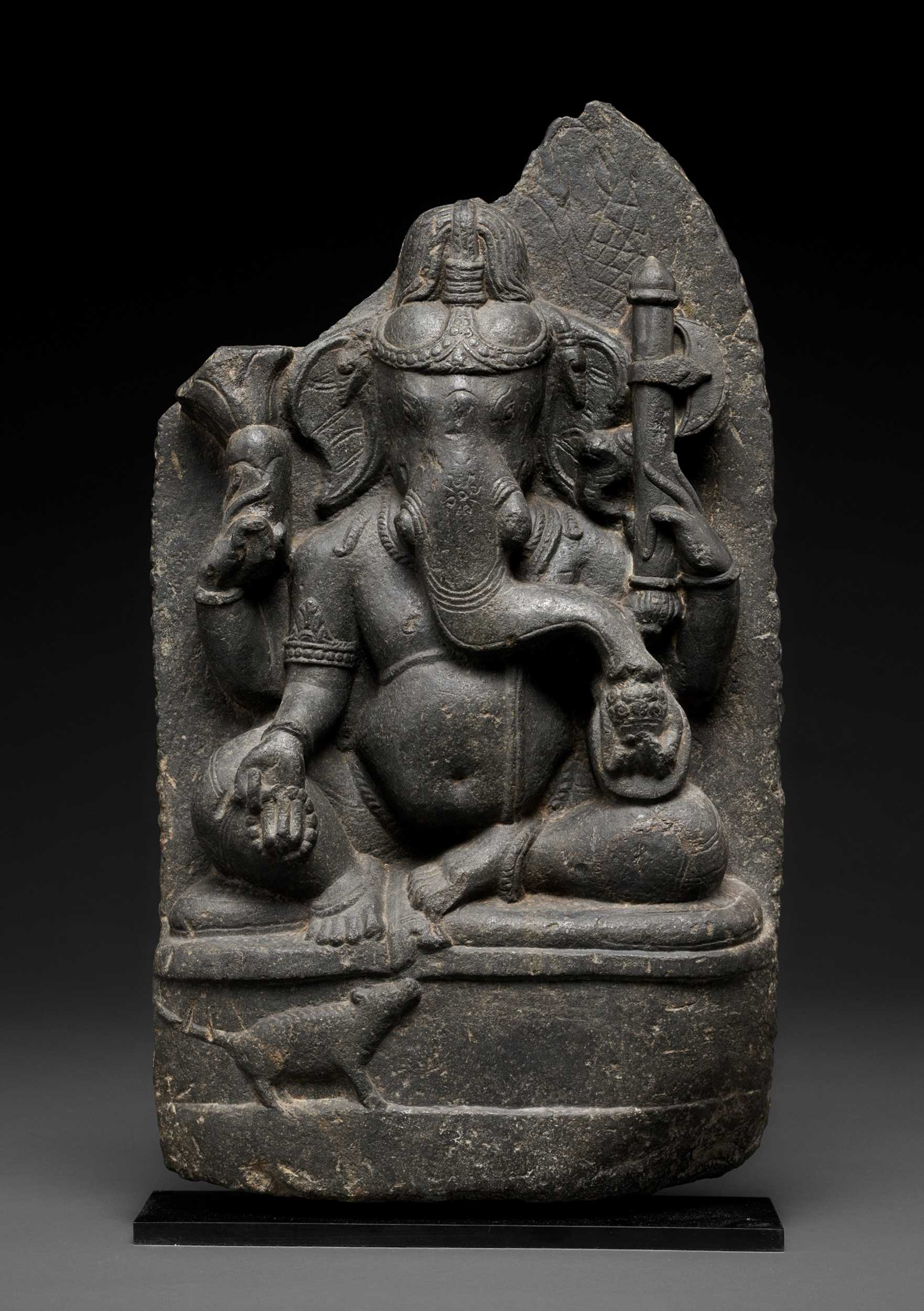11th Mar, 2022 10:00
DAY 2 - TWO-DAY AUCTION - Fine Chinese Art / 中國藝術集珍 / Buddhism & Hinduism
597
A BLACK STONE STELE OF GANESHA, PALA PERIOD
Sold for €16,432
including Buyer's Premium
Northeastern India, circa 10th century. Seated in lalitasana, holding a mala, radish, axe, and bowl of sweets in his four hands, dressed in a short dhoti and adorned with various jewelry, the face with curling trunk and elongated eyes flanked by wide ears and surmounted by a low chignon secured with a jeweled headband, the base below carved with a rat.
Provenance: Collection of Jean-Marc Andral, acquired between 1991 and 1994 in the local trade in Miami, Florida, USA. Jean-Marc Andral is a Belgian manager based in Brussels and active in the healthcare industry for over 25 years.
Condition: Excellent condition, commensurate with age. Extensive wear, losses, nicks and scratches, signs of weathering and erosion, encrustations, few structural cracks. Solid, naturally grown patina.
Dimensions: Height 62 cm (excl. stand) and 64 cm (incl. stand)
With an associated metal stand. (2)
Ganesha, the son of Shiva and Parvati, is known as the giver of counsel and remover of obstacles for humans and deities alike. Although his elephant-headed form lends a playful quality, Ganesha's significance is profound. As overseer of the relationship between past, present, and future, Ganesha maintains balance in the universe. He is typically worshipped at the beginning of rituals. Known in India for his youthful cleverness and predilection for pranks, Ganesha is frequently depicted dancing or standing in tribhanga.
According to legend, Ganesha took on his elephant-headed form when he was a little boy. While Shiva was out, Parvati wanted to bathe but had no one to guard the door. She fashioned a little boy with her hands and instructed him to mind the entry to the bathing area and not permit anyone inside. When Shiva returned home and found an unknown boy refusing him entry, the angered god cut off the boy’s head without asking further questions. Emerging from her bath, Parvati was dismayed to see what had transpired. She commanded Shiva to revive the son she had created by appending the head of the first being who walked by. When an elephant soon passed, Shiva removed its head and attached it to the body of the boy, thus bringing him back to life as the elephant-headed deity known as Ganesha.
Auction result comparison: Compare a closely related stele, 53.3 cm high, also dated circa 10th century, at Christie’s New York in Indian and Southeast Asian Art on 18 September 2013, lot 238, sold for USD 43,750.
Northeastern India, circa 10th century. Seated in lalitasana, holding a mala, radish, axe, and bowl of sweets in his four hands, dressed in a short dhoti and adorned with various jewelry, the face with curling trunk and elongated eyes flanked by wide ears and surmounted by a low chignon secured with a jeweled headband, the base below carved with a rat.
Provenance: Collection of Jean-Marc Andral, acquired between 1991 and 1994 in the local trade in Miami, Florida, USA. Jean-Marc Andral is a Belgian manager based in Brussels and active in the healthcare industry for over 25 years.
Condition: Excellent condition, commensurate with age. Extensive wear, losses, nicks and scratches, signs of weathering and erosion, encrustations, few structural cracks. Solid, naturally grown patina.
Dimensions: Height 62 cm (excl. stand) and 64 cm (incl. stand)
With an associated metal stand. (2)
Ganesha, the son of Shiva and Parvati, is known as the giver of counsel and remover of obstacles for humans and deities alike. Although his elephant-headed form lends a playful quality, Ganesha's significance is profound. As overseer of the relationship between past, present, and future, Ganesha maintains balance in the universe. He is typically worshipped at the beginning of rituals. Known in India for his youthful cleverness and predilection for pranks, Ganesha is frequently depicted dancing or standing in tribhanga.
According to legend, Ganesha took on his elephant-headed form when he was a little boy. While Shiva was out, Parvati wanted to bathe but had no one to guard the door. She fashioned a little boy with her hands and instructed him to mind the entry to the bathing area and not permit anyone inside. When Shiva returned home and found an unknown boy refusing him entry, the angered god cut off the boy’s head without asking further questions. Emerging from her bath, Parvati was dismayed to see what had transpired. She commanded Shiva to revive the son she had created by appending the head of the first being who walked by. When an elephant soon passed, Shiva removed its head and attached it to the body of the boy, thus bringing him back to life as the elephant-headed deity known as Ganesha.
Auction result comparison: Compare a closely related stele, 53.3 cm high, also dated circa 10th century, at Christie’s New York in Indian and Southeast Asian Art on 18 September 2013, lot 238, sold for USD 43,750.
Zacke Live Online Bidding
Our online bidding platform makes it easier than ever to bid in our auctions! When you bid through our website, you can take advantage of our premium buyer's terms without incurring any additional online bidding surcharges.
To bid live online, you'll need to create an online account. Once your account is created and your identity is verified, you can register to bid in an auction up to 12 hours before the auction begins.
Intended Spend and Bid Limits
When you register to bid in an online auction, you will need to share your intended maximum spending budget for the auction. We will then review your intended spend and set a bid limit for you. Once you have pre-registered for a live online auction, you can see your intended spend and bid limit by going to 'Account Settings' and clicking on 'Live Bidding Registrations'.
Your bid limit will be the maximum amount you can bid during the auction. Your bid limit is for the hammer price and is not affected by the buyer’s premium and VAT. For example, if you have a bid limit of €1,000 and place two winning bids for €300 and €200, then you will only be able to bid €500 for the rest of the auction. If you try to place a bid that is higher than €500, you will not be able to do so.
Online Absentee and Telephone Bids
You can now leave absentee and telephone bids on our website!
Absentee Bidding
Once you've created an account and your identity is verified, you can leave your absentee bid directly on the lot page. We will contact you when your bids have been confirmed.
Telephone Bidding
Once you've created an account and your identity is verified, you can leave telephone bids online. We will contact you when your bids have been confirmed.
Classic Absentee and Telephone Bidding Form
You can still submit absentee and telephone bids by email or fax if you prefer. Simply fill out the Absentee Bidding/Telephone bidding form and return it to us by email at office@zacke.at or by fax at +43 (1) 532 04 52 20. You can download the PDF from our Upcoming Auctions page.
How-To Guides
How to Create Your Personal Zacke Account
How to Register to Bid on Zacke Live
How to Leave Absentee Bids Online
How to Leave Telephone Bids Online
中文版本的操作指南
创建新账号
注册Zacke Live在线直播竞拍(免平台费)
缺席投标和电话投标
Third-Party Bidding
We partner with best-in-class third-party partners to make it easy for you to bid online in the channel of your choice. Please note that if you bid with one of our third-party online partners, then there will be a live bidding surcharge on top of your final purchase price. You can find all of our fees here. Here's a full list of our third-party partners:
- 51 Bid Live
- EpaiLive
- ArtFoxLive
- Invaluable
- LiveAuctioneers
- the-saleroom
- lot-tissimo
- Drouot
Please note that we place different auctions on different platforms. For example, in general, we only place Chinese art auctions on 51 Bid Live.
Bidding in Person
You must register to bid in person and will be assigned a paddle at the auction. Please contact us at office@zacke.at or +43 (1) 532 04 52 for the latest local health and safety guidelines.
